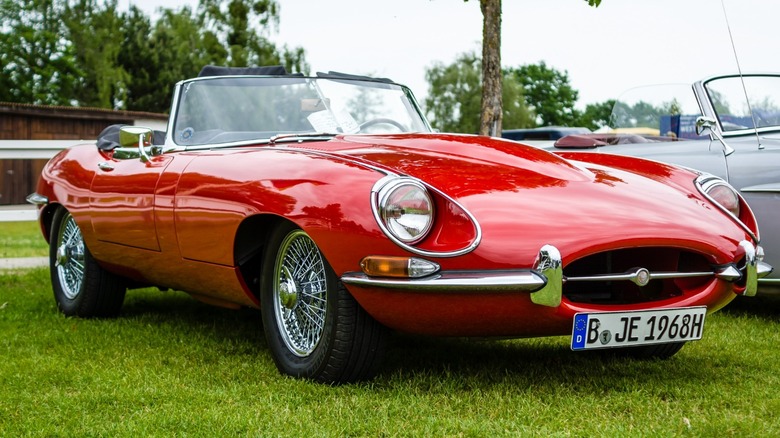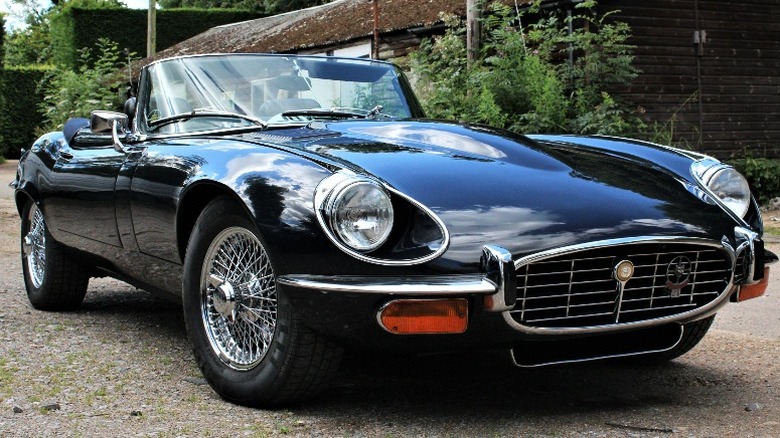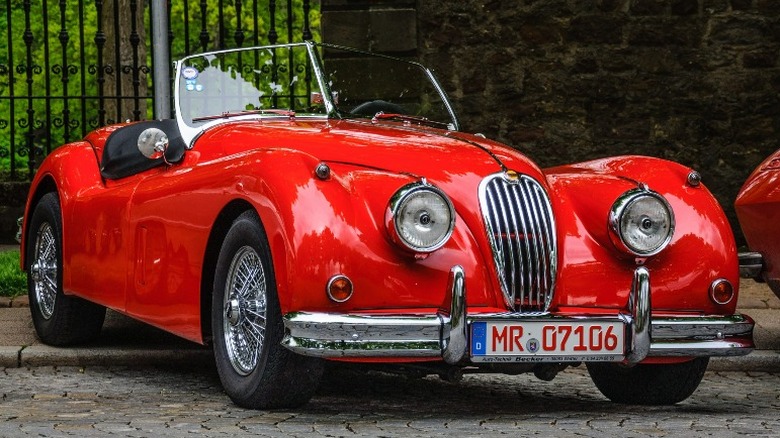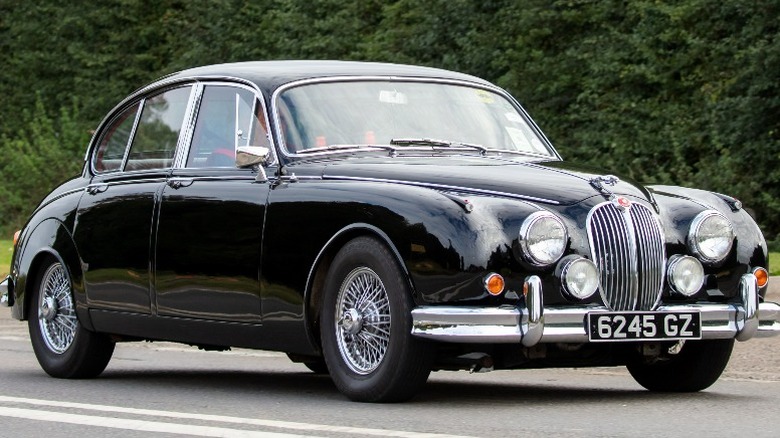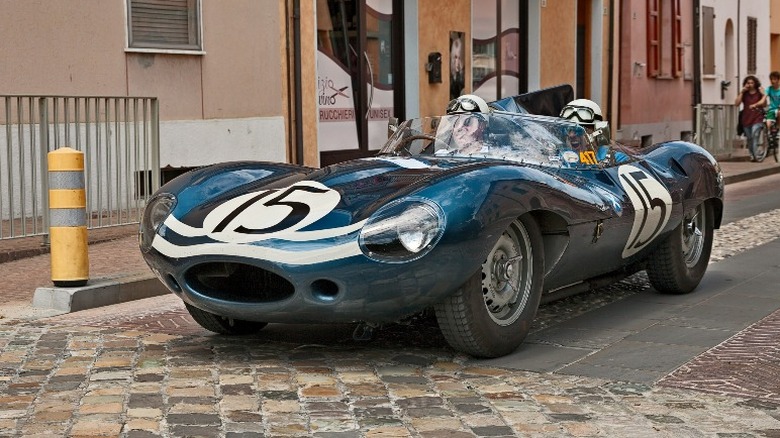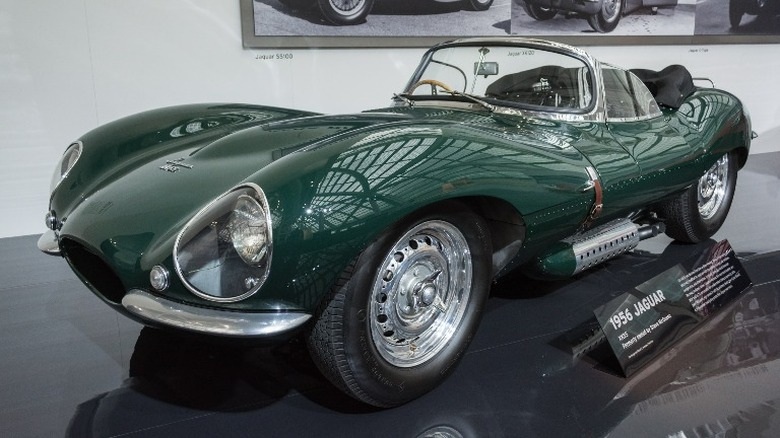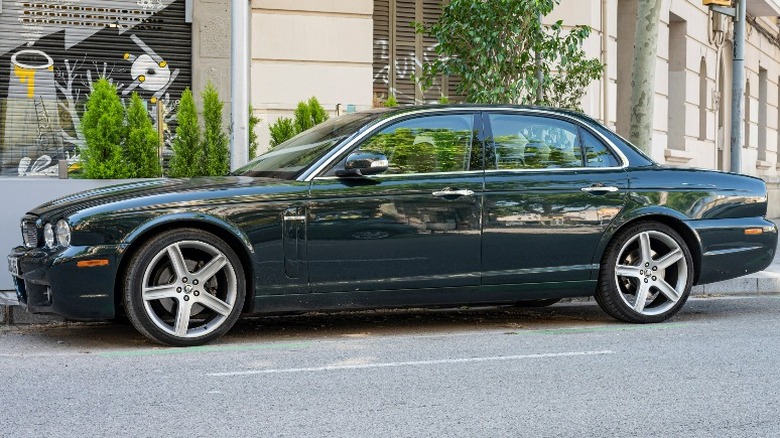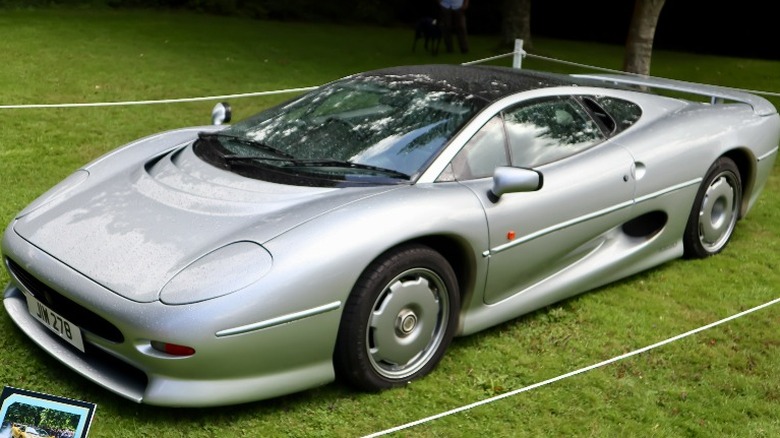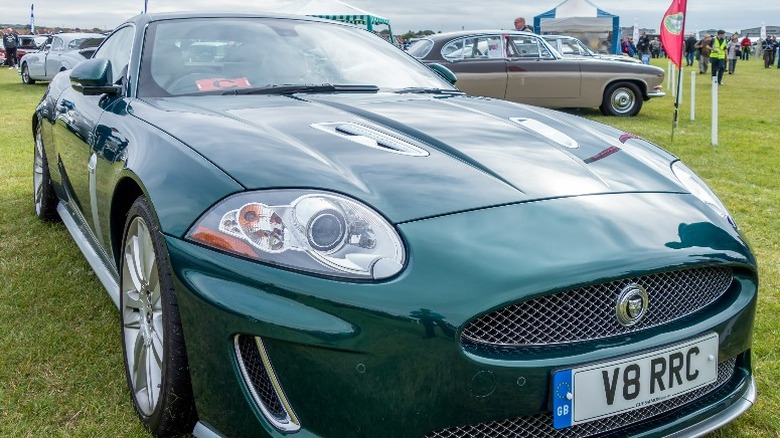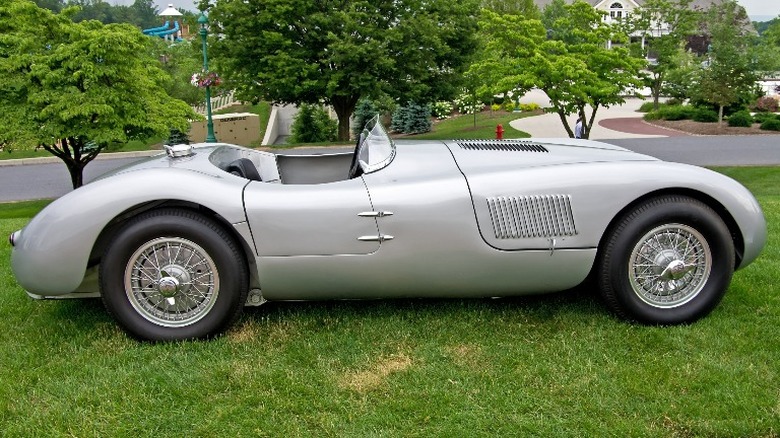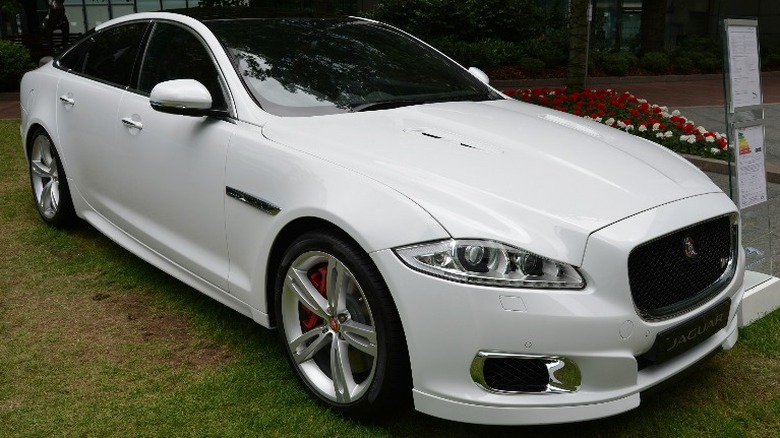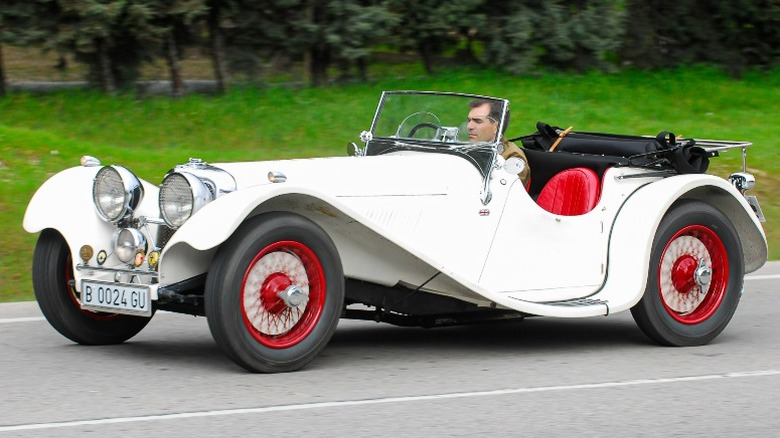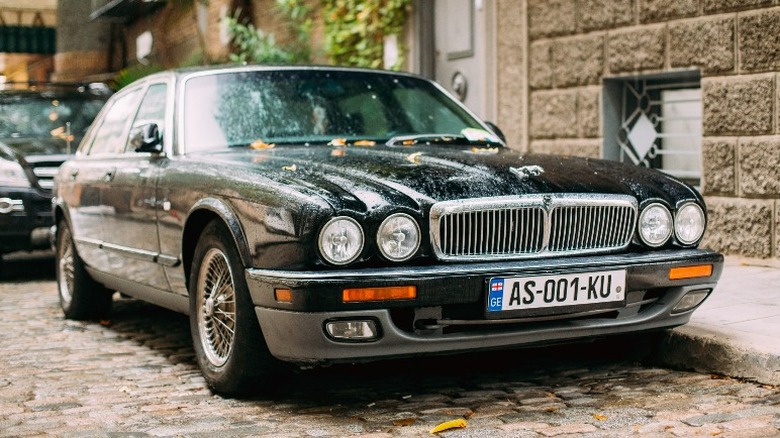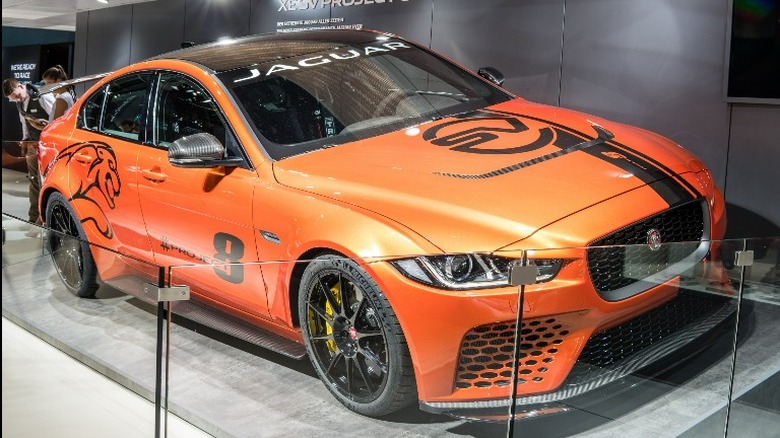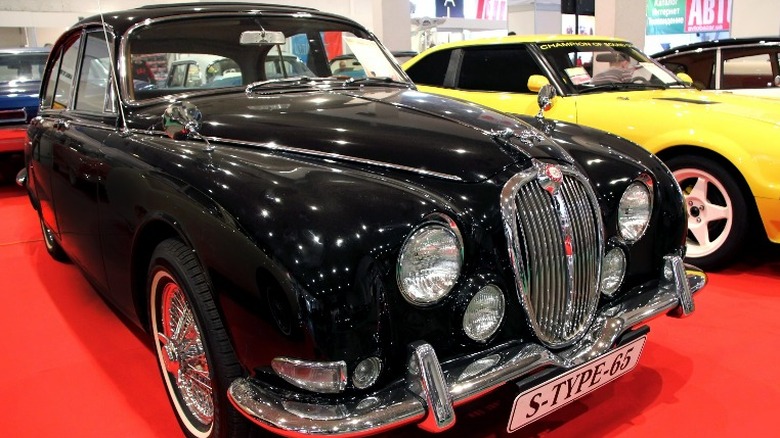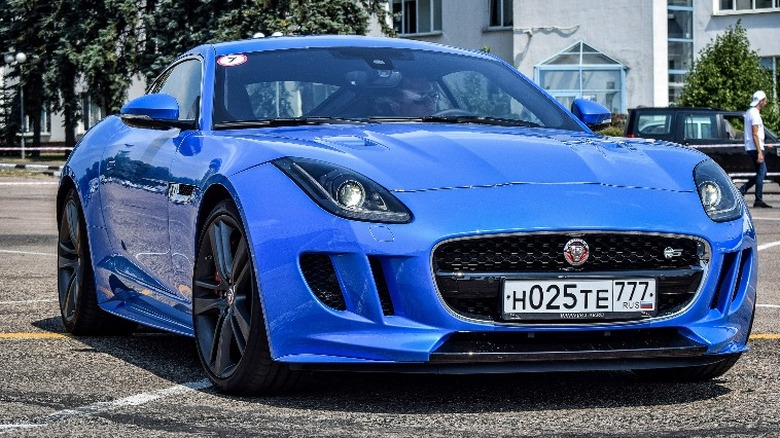The 15 Best Jaguars Of All Time
Jaguar's history features many highs and lows, multiple owners, and several solvency issues. Its origins are traced back to the Swallow Sidecar Company, founded in 1922, an entity that manufactured motorcycle sidecars before designing passenger car bodies. Under the ownership of S. S. Cars Limited, the company changed its name to Jaguar Cars in 1945, and in 1966 merged with British Motor Corporation (via Be Forward). Renamed British Motor Holdings (BMH), the firm merged again with Leyland Motor Corporation in 1968, becoming British Leyland.
In 1984, Jaguar spun off from British Leyland, listing on the London Stock Exchange as a separate company until Ford acquired it in 1990. The merger of Jaguar Cars with Land Rover in 2013 formed Jaguar Land Rover Limited, the company that designs and manufactures both Jaguar and Land Rover vehicles today.
Despite its storied past, most sports car enthusiasts would agree that Jaguar has made some of the most extraordinary, beautiful, and fastest sports cars in automobile history. So revered are Jaguar designs, even Enzo Ferrari declared, at the 1961 Geneva Auto Show, that the E-Type was the "most beautiful car in the world." Although the quote has never been verified by public records nor confirmed by Ferrari's founder before his death, it remains a tribute to Jaguar's exceptional style. Here are the 15 best Jaguars of all time.
Jaguar E-Type
When Jaguar introduced the E-Type in 1961, with its long sleek aerodynamic design, the drop-dead gorgeous sports car (also known as the XK-E) was unlike anything on the road.
The company initially released the E-Type in two trims: a two-seater coupé grand tourer and a two-seater convertible. Several years later, Jaguar added a 2+2 coupé with a lengthened wheelbase. The iconic roadster received accolades for its beauty. In 2004, Sports Car International magazine ranked the XK-E number one on its list of Top Sports Cars of the 1960s, and in March 2008, the Jaguar achieved the top ranking in The Daily Telegraph online list of the "100 most beautiful cars" of all time.
However, the E-Type is also known for its performance and handling, making it one of the most influential vehicles in sports car design. According to Ultimate Specs, Jaguar offered three engines for the E-Type. The 3.8L inline-six produced 260 bhp at 4,000 rpm, while the 4.2-liter XKE, producing 265 bhp, accelerated to 60 mph in a remarkable (for the time) 7.2 seconds and reached a maximum speed of 150 mph. The 5.3L V12 Series 3 produced 314 bhp and accelerated to 60 mph in 7.0 seconds on its way to 135 mph. Using racing technology, Jaguar attached the body tub to a tubular framework that supported the engine, providing extra torsional strength and reduced weight. Along with a front and rear independent suspension, rack and pinion steering, and disc brakes, this offered exceptional handling.
Jaguar XK120
Jaguar launched the XK120 in 1948 as its first sports car made after the Second World War. Produced for six years, the two-seater roadster is still considered to this day one of the most attractive cars ever made. A 3.4L six-cylinder engine with state-of-the-art twin overhead camshafts operating in an aluminum-alloy cylinder producing 160 hp powered the early models, but by 1954 the XK120 developed an impressive (for the era) 210 horsepower.
During early tests, the sportscar reached a maximum speed of 124.6 mph (hence the name), accelerating from 0 – 60 mph in 10 seconds. According to New Atlas, the XK120 held the record for the fastest production car in 1949. The classic road version XK120 featured a wood frame body and handcrafted aluminum panels. Jaguar built the racing versions with lighter aluminum bodies, removable windscreens, more powerful engines, and aero screens designed to shield drivers from oncoming debris.
The British-made car inspired U.S. automakers to design and manufacture their own two-seater roadsters, including the Chevrolet Corvette. Jaguar planned to make only 200 XK120 cars when production began in 1948. However, demand for the classic British sportscar inspired the company to manufacture over 12,000 vehicles during its multiple-year production run, many of them shipped to the U.S. Despite the high production numbers, finding a vintage Jaguar XK120 for sale today is a challenge, and when found, the buyer often pays more than $150,000.
Jaguar Mark 2
Jaguar introduced the MK2, a four-door, mid-size luxury vehicle in 1959 as the successor to the popular MK1. Produced until 1967, the car has become an iconic British sporting saloon, often a top choice for detectives and bank robbers in action movies with car chase scenes. The combination of performance, responsive handling, and interior luxury also created a demand for the Mk2 among classic car enthusiasts.
Improvements to the exterior of the MK2 included slimmer door pillars, larger windows, a broader grille, more glass, and a re-shaped rear end. Interior modifications featured a new dashboard layout with the instruments moved directly in front of the driver, new reclining front seats fitted with picnic tables for use by the rear passengers, and an improved heater. Jaguar improved the MK2 handling with a wide-track rear suspension that alleviated the skittish behavior characteristic of the MK1. A re-angled wishbone front end also helped maintain control though the curves.
The MK2 came with three engine options: a 2.4, 3.4, and 3.8L. The 2.4L produced only 120 bhp and was underpowered for a car weighing 3,204 pounds. However, the 3.8L generating 220bhp at 5500rpm and 240 lb-ft of torque at 3000rpm mated to a four-speed manual (four-speed automatic optional) was more than sufficient for the slightly heavier MK2 weighing 3,288 pounds. The 3.8 Jaguar MK2 accelerates from 0 to 60 mph in a respectable 8.5 seconds and reaches a top speed of 125 mph, with a fuel efficiency of 17 mph.
Jaguar D-Type
The Jaguar D-Type, produced from 1954 to 1957, was a highly successful race car (winning Le Mans in 1955, 1956, and 1957) based on the roadgoing C-Type, but with significant structural and aerodynamic design differences. The D-Type used the 3.4-liter, twin-cam, inline-6 engine that powered both the XK120 and the C-Type. Although the mill that produced between 160 and 180 horsepower made the XK120 the fastest production car in the world, Jaguar felt improvements would make the D-Type an even better race car.
In 1954, when first produced, the D-Type 3.4L engine generated 245 horsepower and eventually cranked out nearly 300 horsepower. Even with the 245 horsepower engine mated to a four-speed manual transmission, the Jaguar accelerated from 0 to 60 mph in 4.7 seconds and reached a top speed of 167.8 mph. However, as remarkable as the D-Type powerplant was, lightweight materials and aerodynamic technology made the race car unique. The D-Type was one of the first cars ever to employ a design using a monocoque tub made with stressed aluminum body panels. Jaguar made the early prototypes with magnesium but switched to aluminum for cost reasons.
The D-type's most characteristic feature, the awkward-looking driver-side rear fin, was not part of the race car's initial design. Jaguar added the fixture to some Le Mans spec cars to improve high-speed stability allowing Jaguar drivers to achieve over 180mph down the Mulsanne straight.
Jaguar XKSS
In 1956, after the D-Type's success in international sports car racing, including victories at Le Mans, Jaguar decided to withdraw from motorsports and focus on road cars. At the time, Jaguar had 25 D-type units in various stages of completion at the Browns Lane plant in Coventry (a factory fire damaged nine cars). Rather than abandon the chassis, the company chose to create a road-legal version of the D-Type by adding a few basic modifications to the bodywork. Hence, the world's first supercar was born, the Jaguar XKSS.
Jaguar added a passenger-side door, eliminating the need to hop in and out of the car, a chrome-framed windscreen and side screens to block the wind at high speed, a folding roof, and chrome front and rear bumpers. However, removing the famous D-Type stabilizer wing behind the driver was perhaps the most significant visual change. The road-legal sports car used the D-type 3.4L engine producing 262 bhp and 260 lb-ft of torque to power the rear wheels via a four-speed manual transmission. According to fastestlaps, the XKSS accelerated to 60 mph in 6.8 seconds and reached a top speed of 159 mph.
In March 2016, Jaguar announced it would complete the originally intended production run of 25 cars by finally building the nine XKSS lost to the Browns Lane fire. Purchasing an original XKSS is out of reach for many collectors, but even a "Continuation" model is untouchable for most. In 2020, a 1957 Jaguar XKSS Continuation sold for $1,985,000.
Jaguar XJ-S
When Jaguar introduced the XJ-S in 1975, it replaced one of the most beautiful British sports cars ever made, the iconic E-Type. While it was still cherished by many enthusiasts, the XK-E was out of date and lagged behind the technological features of its closest rivals. The British car manufacturer surprised critics and buyers with the much bigger luxurious grand tourer.
Jaguar produced the XJ-S for over two decades, and while early sales were disappointing (only 1000 cars in 1980), the model became the most successful Jaguar to date with a total production of over 98,000, breaking the E-Type record. Jaguar launched the XJ-S as a fastback coupe but held off making a convertible for 13 years due to health and safety legislation that dominated the 1970s. During the more than 20 years of production, Jaguar offered various six and twelve-cylinder engines. According to the Automobile Catalog, a 1996 2-door fastback coupe with a 6L V12 producing 298 horsepower accelerated to 60 mph in 6.6 seconds and reached the quarter-mile in 15.2 seconds on its way to a top speed of 162 mph.
In 1991, Jaguar smoothed out the styling of the XJ-S and renamed it the XJS. The new version came with the 4.0-liter AJ6 'Sport' spec engine used in the XJ40, or the larger 6.0L V12 (in 1992). These last vehicles benefited from over 20 years of development and represented the best Jaguar offered in the XJ-S line.
Jaguar XJ220
Jaguar's initial design for the XJ220, unveiled at the British International Motor Show in 1998, proposed a racing car with four-wheel-drive and V12 appropriate for FIA Group B racing. However, the sports car manufacturer's principal competitors, Porsche with its 959 and Ferrari with the F40, had already implemented compact, turbocharged engines that produced more power with less weight.
In collaboration with Tom Walkinshaw Racing, Jaguar decided to abandon the complicated and heavy four-wheel-drive system and replace the V12, plagued by power output, emissions, and reliability problems, with a 3.5L V6 twin-turbocharged engine. The new compact powerplant helped shorten the wheelbase, reduced weight, and offered more power and torque. The V6, mated to a six-speed manual transmission, sent an impressive 542 horsepower and 475 lb-ft of torque to the rear wheels.
According to Motor Trend, the graceful sports car accelerated from 0 to 60 mph in a claimed 3.6 seconds and achieved a top speed of 212 mph. The new Jaguar XJ220 set the record as the fastest production car of its time, albeit only briefly, until the exceptional McLaren F1 blew away the competition in the mid-1990s. However, the record-breaking performance and uniquely elegant shape were insufficient to make the supercar a success. Hit by a global recession and struggling sales, Jaguar produced and sold only 282 (out of the planned 350) XJ220 units between 1992 and 1994. Today, Jaguar XJ220s sell in the $300,000 to $500,000 range at auction.
Jaguar XK
The Jaguar XK is a luxury four-seater grand touring car manufactured from 1996 to 2014 (2015 model year). The first-generation model, known as the XJX, replaced the XJS model and was available as a convertible or coupe until 2006. Initially, Jaguar offered both trims with a 4L V8 generating 290 horsepower, but a few years later upgraded the mill to a 370 horsepower supercharged version of the same engine. Car and Driver claimed an acceleration to 60 mph in 5.9-6.0 seconds, a quarter-mile time of 14.4-14.5 seconds, and a top speed of 155 mph.
In true Jaguar fashion, the luxurious XKX featured an interior made entirely of leather adorned with swirly burled wood panels on the dash, center stack, and console traditionally reserved for sedans. The cars also came with adaptive cruise control and side airbags.
While the first-generation XK was an exceptional grand tourer, the second generation was even better. Introduced in 2007 as a two-door soft-top convertible and two-door coupe, the re-designed XK featured a sleek aluminum body. The lightweight material reduced the coupe's weight by 200 pounds while increasing body stiffness by 30%. The new convertible was 19 percent lighter than the first-generation version but had 50-percent-more torsional rigidity. The changes, coupled with precise steering, resulted in a more muscular and athletic ride. By 2015, the Jaguar XK, with its swooping lines, traditional British styling, and 385-horsepower, had become the quintessential grand touring car.
Jaguar C-Type
The Jaguar C-Type, produced from 1951 to 1953, is one of the most influential cars in automobile history, based on the successful XK120, famous for its 120-mph top speed making it the fastest production vehicle in 1949. The sports car company gave the C-Type a lightweight, aerodynamic body attached to a tube-frame chassis while equipping the race car with the same engine, transmission and front suspension used by the XK120. According to Top Speed, the C-Type equipped with the inline-six producing 210 horsepower coupled to a four-speed manual transmission accelerated to 60 mph in 8.0 seconds (impressive for 1951) and reached a top speed of 140 mph.
Typical of a lightweight race car, exposed aluminum dominates the C-type's interior. Two basic seats and an instrument panel without frills displays the necessary information for racing. A minuscule, frameless windshield provided minimal wind protection and impact from flying debris at high speeds. The race car won the Le Mans 24 Hours race twice and the Reims Grand Prix with Stirling Moss behind the wheel in 1952. The victory was the first with a car using disc brakes, encouraging other car manufacturers to follow suit.
Jaguar produced only 53 C-Types from 1951 to 1953 with an MSRP of about $6,000. Today, resale prices reflect the historical significance and rarity of the original C-Type with recent sales as high as $4.8 million. Several companies currently produce genuine C-Type replicas for collectors with a lower budget limit.
Jaguar XJR-15
The Jaguar XJR-15 traces its roots to a Jaguar Sport and Tom Walkinshaw Racing (TWR) concept car known as Project R9R, developed to test the endurance of plastic and carbon fiber bodywork at high speeds. Borrowing mechanical components from the Le Mans-winning Jaguar XJR-9, the supercar featured a central monocoque "tub" and an aerodynamic body designed by Peter Stevens, perhaps better known for his design work on the McLaren F1.
The 6.0L alloy V-12 with a Cosworth-forged crankshaft, connecting rods, aluminum pistons, and Zytec fuel injection produced 450 bhp and 4500 lb-ft of torque. The extensive use of carbon fiber resulted in a supercar that weighed only 1,050 kilograms. The lightweight and powerful engine combined to push the car to 60 mph in a blistering 3.1 seconds, and a top speed of 215 mph. A racecar suspension featuring fabricated wishbones, front horizontal pushrod-spring dampers, rear coil springs, and disc brakes for stopping power gave the car excellent handling characteristics and race-proven reliability.
Jaguar announced the XJR-15's launch in November 1990 and built the car at Jaguar Sport in Coventry, England, until 1992. The British sportscar manufacturer produced only 53 of the supercars, selling for more than $900,000 each. While Jaguar built some models for professional racing (in 1991, sixteen of the cars raced in Monaco at the Jaguar Sport Intercontinental Challenge), all are currently privately owned.
SS Jaguar 100
In early 1935, Jaguar introduced the SS90 to a market full of drophead coupés and saloons but few two-seaters. While the open-cockpit sports car was stunning, it lacked exceptional performance, using the same six-cylinder side-valve engine as the SS1 saloon. Jaguar sold only 23 units.
In September 1935, when Jaguar announced the SS100 with a 2.5-liter six-cylinder engine featuring overhead valves, 102 horsepower, and a maximum speed of 94mph, many considered it the company's first real Jaguar sportscar. Later, the SS100 got even faster when fitted with a naturally aspirated 3.5-liter inline six-cylinder engine with twin SU carburetors producing 125 hp mated to a four-speed manual transmission, resulting in a top speed of 101 mph. According to Supercars.net, the sportscar reached 60 mph in a respectable 10.8 seconds. At a price of £395 ($2,524.70), the sportscar became Britain's least expensive vehicle to break 100 mph.
The SS100 matched its predecessor in appearance except for a few details, including Lucas de Luxe large-diameter headlights and a re-designed radiator with an attached "SS Jaguar" badge. Jaguar added Dunlop 15-inch, splined center-lock wheels and Girling rod-operated drum brakes operated either by the pedal or hand brake (via Carfolio).
During its production run from 1935 to 1938, Jaguar made 191 2.5L cars and an additional 118 3.5L models in 1938 and 1939. Recently, a 1935 SS100 listed for more than $425,000 (via Hot Cars).
Jaguar XJR-X300
Designed in the Jaguar tradition of sleek lines and exceptional luxury, the XJR-X300 launched in 1994 at the Paris Motor Show, displayed its own unique style with a low overall height and a sloped trunk lid (via Car Scoops). The chromed mesh grille lacking the classic vertical slats and four round headlights gave the sedan a more sinister and menacing look than most of the competition.
The interior featured headroom unsuitable for driver and passengers over six feet tall, but the low-mounted seats helped compensate and made the occupants feel like they were riding in a sports car. The ample wood trims and supple leather could convince any driver Jaguar gave performance a low priority when designing the car. However, the XJR-X300 has better performance than a typical luxury car. The supercharged 4.0L straight-six producing 320 horsepower mated to a five-speed manual or "J-change" four-speed ZF automatic pushes the Jaguar to 60 mph in less than six seconds and to a top speed of 155 mph. The Computer Active Technology Suspension (CATS) system continuously adjusts the XJR's shock absorbers according to the prevailing road conditions and the vehicle's speed, giving the Jaguar superior handling.
Despite the XJR's exotic appearance, competitive performance, and exceptional handling, the sedan's best feature may be its reliability. The car achieved second place in J.D. Power's Initial Quality Survey, making it one of the best and most dependable Jaguars ever made.
Jaguar XE SV Project 8
The Jaguar XE SV Project 8 looks more like a roadgoing car than a track-worthy vehicle. Even the tailored bodywork, the front-mounted splitter, and the massive wing are not enough to convince the casual observer the car is anything more than a passive four-door, four-passenger sedan. But the Jaguar is a remarkable performer, shattering the four-door production sedan record at the Nurburgring with a lap time of 7:21.23, 11 seconds faster than the former record-holder Alfa Romeo Giulia Quadrifoglio. More recently, at WeatherTech Laguna Seca, MotorTrend pro racer Randy Pobst set a production sedan lap record of 1:37.54, surpassing the 1:38.52 previously set by a 2016 Cadillac CTS-V.
Underneath the docile-looking hood, XE SV Project 8 hides a supercharged and intercooled DOHC 32-valve 5.0L V-8 with aluminum block and heads and direct fuel injection generating 592 horsepower at 6500 rpm and 516 lb-ft of torque at 3500 rpm. The massive powerplant sends all that power via an eight-speed automatic with manual shifting mode to all four wheels.
The Project 8, with its carbon fiber components and powerful engine, is Jaguar's highest-performing road car to date. In Motor Trend acceleration tests, the XE SV Project 8 accelerated to 60 mph in a mere 3.2 seconds and reached the quarter-mile in 11.4 seconds at 122 mph. Despite its racecar qualifications, the Project 8 is a comfortable and practical road car with an EPA estimated fuel economy of 16/22 city/highway.
Jaguar S-Type
Jaguar has a long history of designing and producing some of the world's most beautiful automobiles, a tradition that creates excitement in car enthusiasts even before the exotic car manufacturer reveals a new model's body shape and style or test drives confirm high performance. Once introduced, enthusiasts usually fawn over the innovative and artistic form even if performance falls short of expectations.
The 1963 Jaguar S-Type was the exception.
The replacement for the iconic MK2 appeared to be a confusing mix and match of popular Jaguar body styles. Upfront, the S-Type borrowed the hull from the MK2, but with a decidedly flatter roofline, new front wings featured hooded headlamps mounted above slimline bumpers. The rear end style came from the MK X, giving the executive sedan ample trunk space. Critics claimed the new Jaguar looked like a project designed in a hurry.
Despite its ungainly looks, the feature that makes this Jaguar one of the best made and mechanically superior to the MK2 is the rear axle and fully independent suspension, taken directly from the E-Type. The S-Type featured a 3.4L engine producing 210 horsepower and 215 lb-ft of torque. The saloon accelerated from 0 to 60 mph in 9.3 seconds (according to Automobile-Catalog), reached the quarter mile mark in 17.2 seconds and achieved a top speed of 124 mph. With the S-Type, Jaguar had created a car with average performance, less than stellar appearance, but handling characteristics to brag about.
Jaguar F-type
The Jaguar F-Type is a modern high-performance sports car with features and performance characteristics that compete well with other cars in its class and price range, such as the Porsche 718 Boxster, Porsche 718 Cayman, and Chevy Corvette. However, what distinguishes the F-Type Jaguar from the competition and makes it one of Jaguar's best cars ever made, is the powerplant position in front of the driver rather than behind.
When Jaguar introduced the F-Type for the 2014 model year, it was the company's first genuine sports car since the distinguished E-Type. In previous years, Jaguar offered the two-seat sports car with the standard turbo four-cylinder and the optional supercharged V-6. For the 2022 model, the F-type is only available with a V-8 engine. Of the three available trims, R, P450, and P450 R-Dynamic, even the least powerful P450 features a supercharged 5.0L producing 444 horsepower. The P450 comes standard with rear-wheel drive, oversized rear brakes, 20-inch wheels, and an active exhaust system, while the P450 R-Dynamic features all-wheel drive. According to Jaguar, in either RWD or AWD, the F-TYPE P450 accelerates to 60 mph in a nimble 4.4 seconds and reaches a maximum speed of 177 mph.
All three Jaguar F-type trims are available as a coupe or convertible. While each has its advantages, the convertible may be the most enjoyable exposing the driver and passenger to the unfiltered growl of the powerful V-8 engine.
